Georgina Bellamy: Breathing life back into goldwork
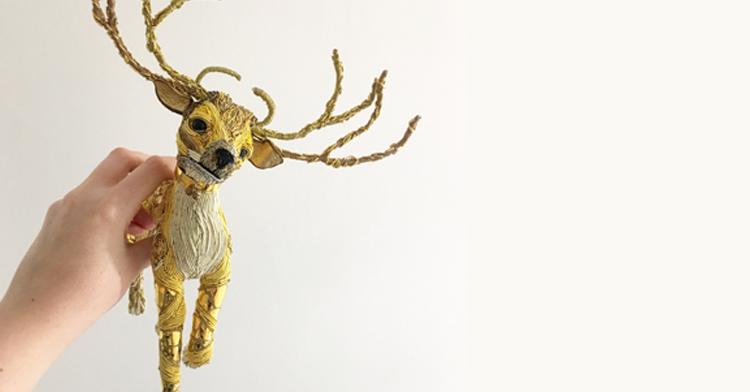
No amount of superlatives would suffice to describe Georgina Bellamy’s work. Her fanciful menageries stitched in gold will take your breath away. Reindeer, frogs, pandas and more come to life with intricate goldwork and exquisite detail.
Georgina is on a mission to bring the age-old tradition of goldwork embroidery back to life, but she’s also turning that tradition a bit on its head. Her 3-dimensional sculptures surprise and trick the eye. And her embroidery-embellished apparel is equally stunning.
We’re so pleased to offer a behind-the-scenes look into Georgina’s process, as well as her philosophy and effort to use her talents to build community. It’s a remarkable story.
Georgina graduated from the London College of Fashion with a BA in surface textiles. She has created embroidery for various fashion designers, artists and students, which led to her founding her own brand called ‘That Embroidery Girl.’ Her work has been featured on TV, in magazines, and her ‘In My Garden’ exhibition is featured in the current UK ‘Knitting and Stitching Show.’ Georgina also offers classes in southeast London to help preserve the goldwork craft and provide access to the tradition to lower-income students.
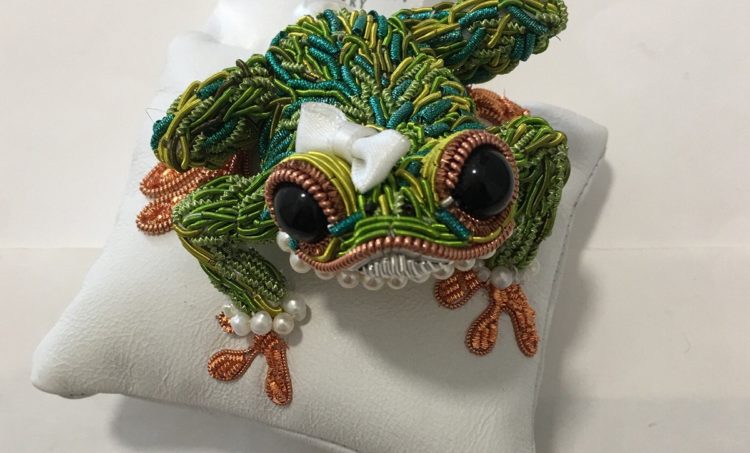
A goldwork obsession
TextileArtist.org: What initially attracted you to textiles as a medium? How was your imagination captured?
Georgina Bellamy: Textiles initially attracted my attention in my early 20’s when taking City and Guild’s clothes-making and textile classes at my local adult education college. I added hand embroidery to everything I made during those classes, as the garments seemed so plain without it.
But I’ve always been attracted to ornate and intricate decorations, even as a child. I grew up in an old Victorian house with baroque-embossed wallpapers and old chandeliers, and this nurtured a love for all things grand and over-the-top.
Hand embroidery quickly became the perfect medium to create similar levels of detail and intricacy, and I became quite obsessed with it.
My embroidery journey began with couching but quickly developed into stumpwork and more innovative embroidery development. I would embroider anything just to see if it could be embroidered: an orange peel, wood bark, tyres—I tried them all!
But I was happiest when creating more couture-inspired work with beads and hand stitches.
I then discovered goldwork and all the wonderful metals it offered while working on my degree. I’d seen so many images of this form of embroidery where the finished results were almost like jewellery. It satisfied my love of fine details, so I became quite determined to master it.
I had heard goldwork was one of the most difficult and technical forms of embroidery, but I was lucky enough to have a university goldwork tutor who had worked for Hand and Lock (London’s premier embroidery house established in 1767).
I also bought all the books I could on the subject, including historical information. Knowing there was so much heritage attached to goldwork captured my imagination even more. I felt I was helping keep history alive, and it became so much more than just embroidery.
By the end of my degree, my whole final fashion collection had been created exclusively by hand in light of that tradition. I felt I had a duty to implement my skills and keep hand embroidery alive and relevant in a modern fast-fashion world. And that idea still inspires me to this day.
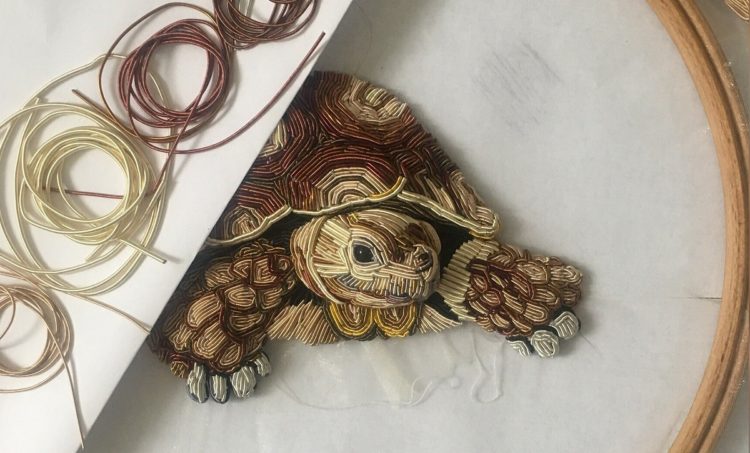
What or who were your early influences and how has your life/upbringing influenced your work?
Creativity was everywhere growing up. My mother’s side of the family had many creatives. I have an uncle who is a professional painter and another uncle who makes all manner of things out of metal.
I also had an aunt who often knitted dolls’ clothes, hats and scarves. My littlest sister always drew cartoons, and my middle sister always wrote creative stories.
Growing up without a father figure and two similarly-aged sisters meant my mother often worked late or was occupied by household duties. So, we had a very relaxed upbringing, and our imaginations really ran wild. I think that the relaxed setting further encouraged my artistic tendencies.
I was also homeschooled until 15, and during my free time, I asked my mother to enrol me in creative classes at the local community college. I took porcelain doll making, jewellery making, batik dyeing, pottery—all manner of things until I went to college.
Looking back, I think all of those experiences had a huge impact on me and how I behaved. I was a very different teenager from my peers, and my feelings of being ‘the odd one out’ pushed me even further into my creativity.
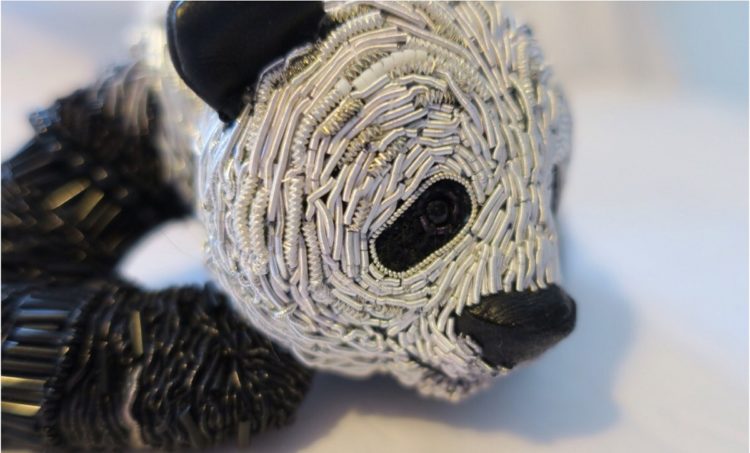
What was your route to becoming an artist?
My route to becoming an artist is so layered it’s hard to define its real starting point. By my early 20s, I had a son, and I didn’t really know what I wanted to do with my life.
I was working at a dry cleaner at the time, and part of my job was taking apart clothes prior to being altered. I learned a lot about clothing construction, and after a while, I got a creative itch to make my son a leather bomber jacket. He was obsessed with cats, so I haphazardly embroidered them all over the jacket.
My son’s father was so proud of my work he had our son wear that jacket everywhere. People often asked where we had bought the jacket, so he convinced me to think about creating some children’s clothes.
I wasn’t confident in my ability to make them to a high enough standard to sell, so I began to look up courses in clothes making at my local adult education college. I found some affordable city and guilds qualifications in fashion and textiles and applied. This really started my embroidery obsession.
I studied at adult education centres all over southeast London for the next two years, taking every city and guilds qualification related to textiles I could find. I didn’t have an end goal. They just made me so happy, I couldn’t give them up.
Luckily, along the way, an external examiner who also worked for the London College of Fashion examined some of my work and suggested I apply for an embroidery degree at the university. University was not something I had ever considered before and certainly not for embroidery. But the more I thought about it, the more my gut told me to go for it.
I had learned many hand embroidery skills from my years of adult education classes, but my design skills were sorely lacking. So, my degree at LCF taught me so much in that respect.
After graduation, I was lucky enough to gain employment in a design studio working on embroidery for designers, artists and students, and all that led me to set up my own brand and become independent.
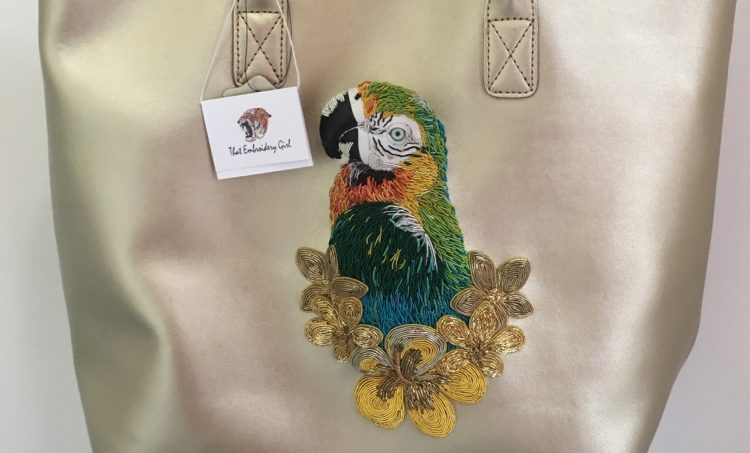
‘Purls’ of wisdom
Tell us about your process from conception to creation
Every single piece I create starts with a sketch or tracing. Because I create 3-D embroidery, it’s very important I gain an understanding of what the finished piece will look like from all angles.
The animal gets broken down into a series of shapes. I then determine if these shapes are really what I’m seeing or what I expect to see. Sometimes my mind plays tricks and leads me to create shapes that aren’t present in real life. This can make an animal look quite cartoonish if not reined in, so careful planning of the shapes is needed.
When creating a sculpture with goldwork, it’s really more about the pressure exerted than anything else. So I am careful to explore that pressure before applying the metals fully.
The goldwork techniques I use really depend on the animal being created. I have developed techniques for furry and smooth-skinned animals and particular ways to bring out certain features.
I mainly focus on eyes. I often think if I get those right the rest of the sculpture will fall into place fairly easily. I often draw these many times before attempting a sculpture to gain an understanding of the shape I need to create.
Colours are also often carefully planned. Purls (metals used for goldwork) have a far more limited colour range compared to threads, so I created an archive of these metals over the years and now have many shades. These shades often feature discrepancies in the dye lots, but the manufacturer’s mistake often makes my day!
I particularly like to find inferior wires that haven’t been dyed correctly and often have uneven tones throughout the wire. I use them to create some wonderful effects in my pieces.
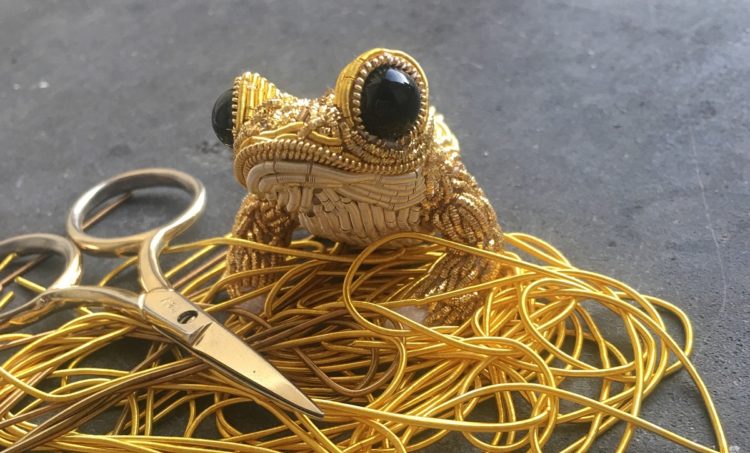
Tell us a bit about your chosen techniques and how you use them
Even in my early days, I have always been a multidimensional embroiderer. I cannot seem to work flat, and my need to discover and create something akin to embroidered sculpture has always been present in my work.
While at university, I began to develop techniques that bridged stumpwork and goldwork together in fully 3-D forms. It was an idea I worked on for years making heads and tiny animals. I would often create little 3-D creatures, and they would teach me something new about the metals and how to make the finished product better.
Goldwork creates a very hard surface, particularly when using metal purls. And it can form a very rigid structure when stitched closely together. So, I became immersed in ideas of how to create sculptures with them early on.
Traditional 3-D goldwork only goes so high and often has a boxy shape because thick felts and cards are used. I wanted to come away from that tradition and create 3-D goldwork in a very different way. I much preferred smooth lines and fine details, so I worked on ways to create those effects in a 3-D form with the metals.
3-D embroidery, and goldwork, in particular, is a technique that consumes me to this day and is the only type of embroidery work I do. There is still so much to learn about those little coils of metal. Every time I think I have exhausted an idea with them something else becomes a possibility. And that’s helped my work develop a very distinctive style that’s unique to me.
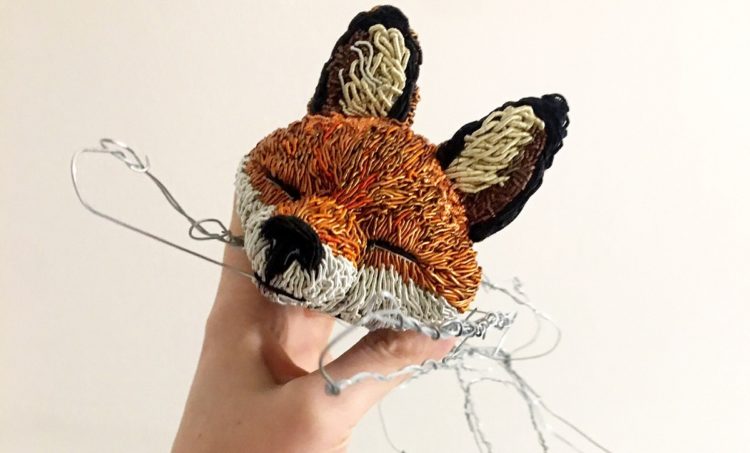
What currently inspires you?
At the moment I am fascinated with creating larger pieces and all things Spanish goldwork related. The Spanish have a real flair for creating 3-D goldwork over a card and felts with underside couching. They also layer up several embroideries at a time and create ornate patterns with the metals.
I’m itching to combine these techniques with my own. I love the idea of an ornately patterned bear or elephant sculpture and can’t wait for some free time to see if this fusion works.
The next stage of my work is linking the animals back to the couture fashion embroidery that inspired me so much as a student, and I can see the Spanish techniques as a pathway to that. Working on a larger scale also intrigues me. I want to push my techniques and ideas to the maximum and explore how big I can go.
There are also so many other animals to create. I seem to find a new and interesting shape every day that sparks off a new idea. I am really driven to create a sense of wonderment in my pieces.
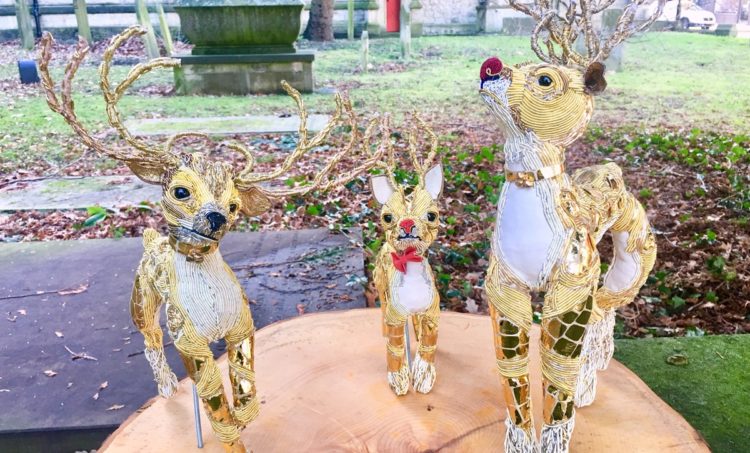
Building community through stitch
Tell us about a piece of your work that holds particularly fond memories and why?
My trio of goldwork reindeer made for TV Channel 4’s ‘Handmade Christmas’ in 2018 are my favourites. I had originally pitched making a single golden reindeer, which by the way, was an animal I had never made before. So as soon as the proposal was accepted, the pressure was on to create the deer shape.
The window of time was so small and nerves stopped me from sleeping many times. It took at least three attempts before I got a head I was happy with.
Then I kept thinking about how lucky I was to go on national TV and introduce the world to goldwork, and I became convinced I had to put my best foot forward and create something even more unique.
That’s when the idea of a golden Rudolf, female deer and baby reindeer was born. But, of course, that led to even more pressure! I worked into the night for many nights to finish on time.
Still, I cannot express the joy I had watching the trio being showcased. So many people emailed me inquiring about goldwork, and I felt I had given goldwork the platform it deserved. I was so proud.
I am also extremely proud and excited about a current venture I have with my local church. I’m providing more of a ‘movement’ than a piece of work by offering affordable community embroidery lessons. Many embroidery admirers told me the main barrier to their stitch education was the high prices of classes. So, I decided to teach some basic goldwork techniques at an affordable price each month.
It’s exciting to see how my students not only learn how to stitch, but they’re also seeing how beneficial craft and art can be for their mental wellbeing. I’m hoping this community work will improve people’s lives and preserve the goldwork traditions for future generations.
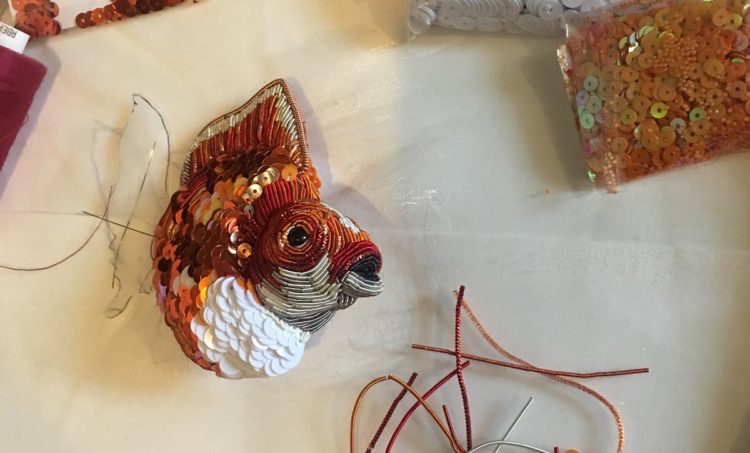
How has your work developed since you began and how do you see it evolving in the future?
It’s been a long journey from my first embroidered piece to where I am now, and so much in my life and expertise has changed. When I started, I had no real grasp of the various forms of embroidery or how to execute them. But as my knowledge expanded, so did my work.
Each piece still teaches me something new. Even shapes I make regularly, like frogs, still surprise me as I find more foundation shapes from which I can make them.
The aim now is to create something that looks alive. This is a distinct change from the beginning of my 3-D goldwork.
It’s an exciting time to be a goldworker as more and more companies create the wires and the colour options are opening up. I’m excited to find people who can now colour match metals for me, and as a result, I’ll be able to further develop my work in ways I can’t even fathom. My levels of detail will be able to reach even higher.
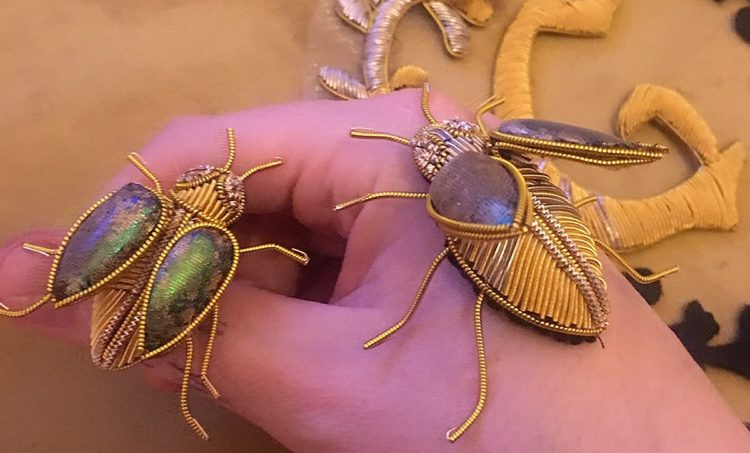
What advice would you give to an aspiring textile artist?
Spend time developing your own voice. The years I’ve spent doing so were crucial in helping me develop my style and future direction.
Authenticity in your work is really important, so resist the urge to jump on a trend or copy others. Doing so detracts from you in the long run and can damage your reputation and work.
Social media is a game-changer for getting artists’ works noticed. This is brilliant news, particularly for those of us who didn’t have a traditional route into their career. Become social media savvy and push your presence as hard as you can.
The life of a textile artist can often be a hard path to tread, but even when times get tough, you have to remember you can do whatever you set your mind to. This career is not built in a day. It takes many years to become a success.
Enjoy the journey and never give up. It will happen. It just takes time.
For more information visit www.thatembroiderygirl.com
Have you worked with goldwork or other historical stitch traditions? Let us know in the Comments below
















these are spectacular-i have never seen such work. just beautiful.
Wonderful article! I truly enjoyed reading about this amazing artist’s work.
No, I have never done goldwork. The historical stitch tradition I favor is boro-inspired stitching, with some modern touches added.
I have so much enjoyed Georgina’s story! I have admired her work on needle and thread Facebook page. Such a lot of study and thought goes into her beautiful pieces. I love working with gold and metal threads but more traditional.
I look forward to seeing more from Georgina and her animals.
Thankyou ‘textile artist’ for all your articles.
they are so talented people ❤
Wow wow wow. I’ve just started gold work and she’s just blown my mind! Fantastic
Do you sell any of your work and if so where? They are beautiful pierces of art.
Fascinating stuff! Thanks for all your interesting articles.
So interesting to hear about Georgina’s creative journey. Beautiful work!
Love your work, first saw it at K&S in Harrogate, it is so different and a joy to see.